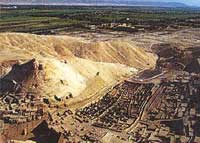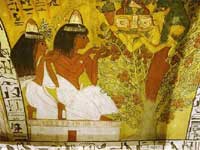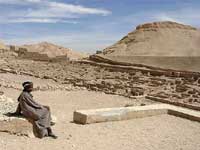|
Deir El Medina
 Just southeast of the Valley of the Queens is Deir el-Medina,
the ruins of a village that housed the craftsmen and workers who
dug and decorated the tombs and other Theban monuments. Just southeast of the Valley of the Queens is Deir el-Medina,
the ruins of a village that housed the craftsmen and workers who
dug and decorated the tombs and other Theban monuments.
It is a very important area to Egyptology, because it has
revealed many of the facets of ordinary life in Egypt, and there
are some wonderful tombs in its necropolis.
Deir el-Medina dates to the New Kingdom. Deir el-Medina, which
in Arabic means "monastery of the city", was called Pa-demi by
the workmen, simply, "the town," though it was also called Set
Maa, "the place of truth." is one of the most well-preserved
ancient settlements in all Egypt.
 It lies near Thebes and was a highly skilled community of
craftsmen who passed their expertise on from father to son. It lies near Thebes and was a highly skilled community of
craftsmen who passed their expertise on from father to son.
The community included the workmen and their wives, children and
other dependents, as well as coppersmiths, carpenters, potters,
basket-makers, and a part-time physician.
The workers belonged to what we today would call the middle
class, having no royal or noble connections, and much of their
work was unglamorous.
 These workers cut and prepared the tombs in the Valley of the
Kings and in the Valley of the Queens, both on the West Bank at
Thebes, and were administered directly by the vizier. These workers cut and prepared the tombs in the Valley of the
Kings and in the Valley of the Queens, both on the West Bank at
Thebes, and were administered directly by the vizier.
They were better educated and better paid than the vast majority
of their contemporaries elsewhere in Egypt.
Because of their great skill the workers built their own
personal tombs which were always beautifully decorated with
paintings on the walls and ceilings. One such tomb is that of
Sennedjem where paintings depict husband and wife worshiping the
gods of the After-life. |